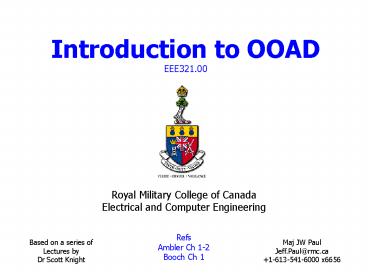OBJECT ORIENTED TECHNOLOGIES - PowerPoint PPT Presentation
1 / 23
Title:
OBJECT ORIENTED TECHNOLOGIES
Description:
Based on a series of. Lectures by. Dr Scott Knight. Royal Military College of Canada ... All the world's an analogue stage and digital circuits only play bit ... – PowerPoint PPT presentation
Number of Views:108
Avg rating:3.0/5.0
Title: OBJECT ORIENTED TECHNOLOGIES
1
Introduction to OOAD EEE321.00
Royal Military College of Canada Electrical and
Computer Engineering
Refs Ambler Ch 1-2Booch Ch 1
Maj JW Paul Jeff.Paul_at_rmc.ca 1-613-541-6000 x6656
Based on a series of Lectures by Dr Scott Knight
2
Why are you here?
3
Course Goals
- introduction to Object-Oriented Analysis and
Design (OOAD) techniques, using the Unified
Modeling Language (UML) - provide a foundation in object-oriented concepts
and terminology - to provide hands-on experience with an
object-oriented CASE tool while developing Java
language skills
4
Course Conduct
- Father So, Jimmy, what did you learn in
school today? - Jimmy Apparently not enough. They want us to
come back tomorrow. - Individual work
- Partners for lab
- Attribution
5
Course Content
- Managing Complexity 1 period
- Object Model 3 periods
- Objects and Classes relations 8 periods
- Objectory Design Method 2 periods
- RUP design process (examples) 10 periods
- Implementation issues 6 periods
6
Course Tools
- Eclipse IDE
- www.eclipse.org
- already installed in the labs
- Rational Rose
- installed in the labs
7
Why am I here?
- All the worlds an analogue stage and digital
circuits only play bit parts...
8
Contact Information
- Major JW Paul
- Office S4008
- Local 6656
- Jeff.Paul_at_rmc.ca
- tarpit.rmc.ca/paul/EEE321B/EEE321B.html
9
References
- See also - http//www.mindview.net/Books/TIJ/
10
Course Marking Guide
- laboratory work (7 labs) 15
- assignments 5
- midterm exam 20
- final exam 60
11
Lab Reports
- Experience is something you get just after you
really need it - what you did
- why you did it
- how you did it
- Attribution
- Labs will be due on Monday at 1300hrs
12
Why OOAD?
13
Software Characteristics
- 1. Software is developed or engineered, not
manufactured in the classical sense - Different use of people
- 2. Most software is custom-built, rather than
being assembled from existing components. - Presently few applications with catalogues of
software components - software usually comes off-the-shelf only as a
complete unit - no standard building codes
- 3. Software doesnt wear out
- Failure rate for hardware follows a classic
bathtub curve - Software is not subject to environmental maladies
that cause wear out
14
Bathtub curve
wear-out
software curve (actual)
break-in period
change
hardware curve
software curve (ideal)
15
Why is software so complex?
- The complexity of the problem domain
- large number of competing, even contradictory
requirements - users and developers have problems in mutual
understanding - requirements change (often as a result of
software development) - Difficulty in managing the Development Process
- large problems lead to large development teams
- more developers means complex communication
- Flexibility Possible Through Software
- software houses capable of building any building
block ... so they do - no standard building codes
- Behaviour of Discrete Systems
- continuous vs. Discrete system
- (eg. Bouncing ball as a system)
16
How have we coped?
- New programming languages
- New programming procedures
- Silver bullets...
17
Programming Languages
- 1st Generation machine code
- 2nd Generation assembler language
- 3rd Generation modern languages
- 4th Generation
- Goal is to reduce the complexity of programming
the computer with the pre-determined solution
formula monolithic structure
procedures structured style
modules data hiding
18
Programming Procedures
- Flowcharts
- Structured Programming
- Data Flow Diagrams
- State Machines
19
Data Flow Diagram
20
Structure Chart (call graph)
21
So what now?
- What do these previous techniques have in common?
- All were attempts to reduce a specific complexity
of the problem - OOAD is another step along that path
22
Review
- What are three specific characteristics of
software? - It is engineered
- It is custom-built
- It doesnt wear out
- Why is software so complex?
- The problem domain
- The development process
- Flexibility (changeability) of software
- Behaviour of discrete systems
23
Next Class
- The OO paradigm
- Read Booch p 4-7
- Study Ambler section 2.2 (skim all)
- Bathurst 1
- El-Beltagy 8
- Flynn 3
- Grieve 4
- Heywood 5
- Kusch 6
- Nolet 9































